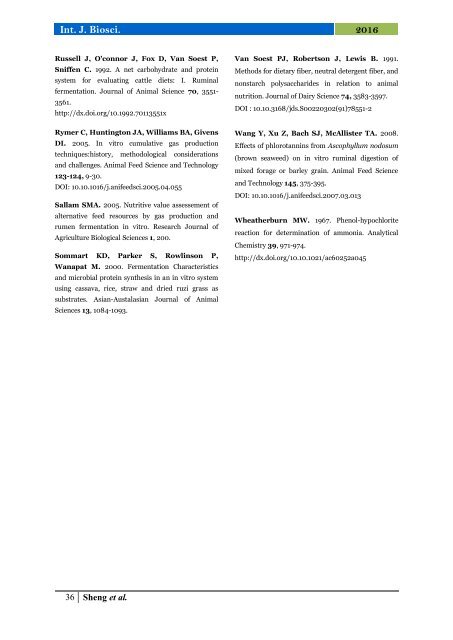Nutrition evaluation of an unconventional for ruminants estimated by the in vitro fermentation system
For sustainable intensification of ruminant industries, it would be wise to explore the potential of unconventional feedstuff resources. Chinese medicine residue (CMR) is of interest due to its high nutrient, low cost and large quantities, indicating its potential as an unconventional feedstuff for ruminants. In this study, in vitro ruminal fermentation technique was used to evaluate the potential ruminant feedstuff. The chemical analysis showed that CMR had higher concentrations of crude protein and lower concentrations of crude fiber, neutral detergent fiber and acid detergent fiber than those of some conventional feedstuff, such as peanut vines, chinese sedge and rice straw, indicating its high nutritional quality. Cumulative gas production was recorded at 6, 12, 18, 24 and 48 h of incubation periods and the pH, ammonia-N (NH3-N), microbial protein production (MCP) and volatile fatty acid (VFA) were estimated at 48 h of incubation period. Our results showed that the fermentation gas volume was greatest in CMR group, followed by peanut vines and chinese sedge group, and the gas volume in rice straw group was only 53.60 % of that from CMR group at 24 h. For MCP and VFA, CMR group also showed the highest value (MCP: 1.34 mg/ml; VFA: 4.33 mg/ml) than other groups, whereas rice straw group showed the least value (MCP: 1.03 mg/ml; VFA: 3.09 mg/ml). Besides that, we also found that the acetate to propionate ratio (A/P) was significantly lower in CMR group (1.21) than others. Based on these results therefore, Chinese medicine residue could be a valuable alternative unconventional animal feed source in ruminant feeding and could economize the ruminants production.
For sustainable intensification of ruminant industries, it would be wise to explore the potential of unconventional feedstuff resources. Chinese medicine residue (CMR) is of interest due to its high nutrient, low cost and large quantities, indicating its potential as an unconventional feedstuff for ruminants. In this study, in vitro ruminal fermentation technique was used to evaluate the potential ruminant feedstuff. The chemical analysis showed that CMR had higher concentrations of crude protein and lower concentrations of crude fiber, neutral detergent fiber and acid detergent fiber than those of some conventional feedstuff, such as peanut vines, chinese sedge and rice straw, indicating its high nutritional quality. Cumulative gas production was recorded at 6, 12, 18, 24 and 48 h of incubation periods and the pH, ammonia-N (NH3-N), microbial protein production (MCP) and volatile fatty acid (VFA) were estimated at 48 h of incubation period. Our results showed that the
fermentation gas volume was greatest in CMR group, followed by peanut vines and chinese sedge group, and the gas volume in rice straw group was only 53.60 % of that from CMR group at 24 h. For MCP and VFA, CMR group
also showed the highest value (MCP: 1.34 mg/ml; VFA: 4.33 mg/ml) than other groups, whereas rice straw group showed the least value (MCP: 1.03 mg/ml; VFA: 3.09 mg/ml). Besides that, we also found that the acetate to propionate ratio (A/P) was significantly lower in CMR group (1.21) than others. Based on these results therefore, Chinese medicine residue could be a valuable alternative unconventional animal feed source in ruminant feeding and could economize the ruminants production.
You also want an ePaper? Increase the reach of your titles
YUMPU automatically turns print PDFs into web optimized ePapers that Google loves.
Int. J. Biosci. 2016<br />
Russell J, O'connor J, Fox D, V<strong>an</strong> Soest P,<br />
Sniffen C. 1992. A net carbohydrate <strong>an</strong>d prote<strong>in</strong><br />
<strong>system</strong> <strong>for</strong> evaluat<strong>in</strong>g cattle diets: I. Rum<strong>in</strong>al<br />
<strong>fermentation</strong>. Journal <strong>of</strong> Animal Science 70, 3551-<br />
3561.<br />
http://dx.doi.org/10.1992.70113551x<br />
Rymer C, Hunt<strong>in</strong>gton JA, Williams BA, Givens<br />
DI. 2005. In <strong>vitro</strong> cumulative gas production<br />
techniques:history, methodological considerations<br />
<strong>an</strong>d challenges. Animal Feed Science <strong>an</strong>d Technology<br />
123-124, 9-30.<br />
DOI: 10.10.1016/j.<strong>an</strong>ifeedsci.2005.04.055<br />
Sallam SMA. 2005. Nutritive value assessement <strong>of</strong><br />
alternative feed resources <strong>by</strong> gas production <strong>an</strong>d<br />
rumen <strong>fermentation</strong> <strong>in</strong> <strong>vitro</strong>. Research Journal <strong>of</strong><br />
Agriculture Biological Sciences 1, 200.<br />
Sommart KD, Parker S, Rowl<strong>in</strong>son P,<br />
W<strong>an</strong>apat M. 2000. Fermentation Characteristics<br />
<strong>an</strong>d microbial prote<strong>in</strong> syn<strong>the</strong>sis <strong>in</strong> <strong>an</strong> <strong>in</strong> <strong>vitro</strong> <strong>system</strong><br />
us<strong>in</strong>g cassava, rice, straw <strong>an</strong>d dried ruzi grass as<br />
substrates. Asi<strong>an</strong>-Austalasi<strong>an</strong> Journal <strong>of</strong> Animal<br />
Sciences 13, 1084-1093.<br />
V<strong>an</strong> Soest PJ, Robertson J, Lewis B. 1991.<br />
Methods <strong>for</strong> dietary fiber, neutral detergent fiber, <strong>an</strong>d<br />
nonstarch polysaccharides <strong>in</strong> relation to <strong>an</strong>imal<br />
nutrition. Journal <strong>of</strong> Dairy Science 74, 3583-3597.<br />
DOI : 10.10.3168/jds.S00220302(91)78551-2<br />
W<strong>an</strong>g Y, Xu Z, Bach SJ, McAllister TA. 2008.<br />
Effects <strong>of</strong> phlorot<strong>an</strong>n<strong>in</strong>s from Ascophyllum nodosum<br />
(brown seaweed) on <strong>in</strong> <strong>vitro</strong> rum<strong>in</strong>al digestion <strong>of</strong><br />
mixed <strong>for</strong>age or barley gra<strong>in</strong>. Animal Feed Science<br />
<strong>an</strong>d Technology 145, 375-395.<br />
DOI: 10.10.1016/j.<strong>an</strong>ifeedsci.2007.03.013<br />
Whea<strong>the</strong>rburn MW. 1967. Phenol-hypochlorite<br />
reaction <strong>for</strong> determ<strong>in</strong>ation <strong>of</strong> ammonia. Analytical<br />
Chemistry 39, 971-974.<br />
http://dx.doi.org/10.10.1021/ac60252a045<br />
36 Sheng et al.


















